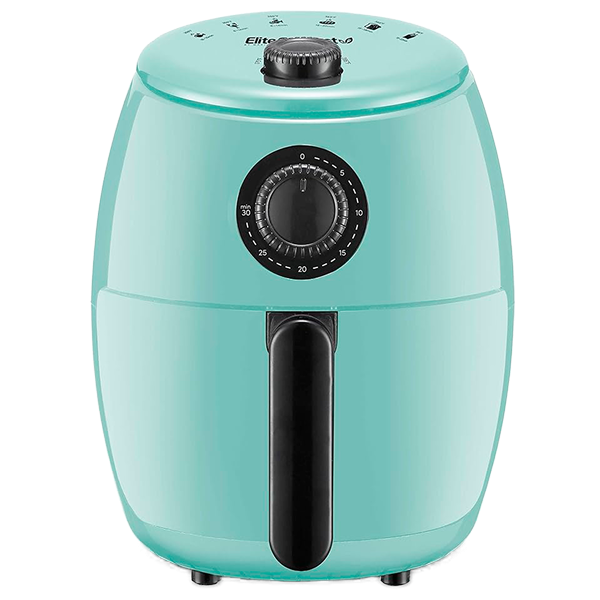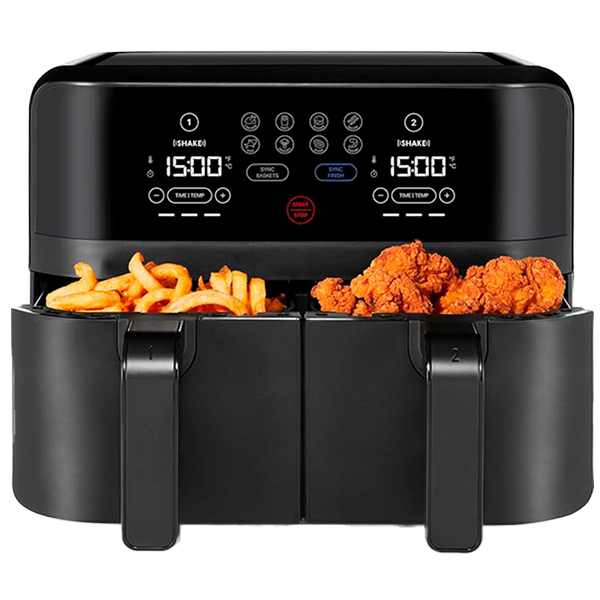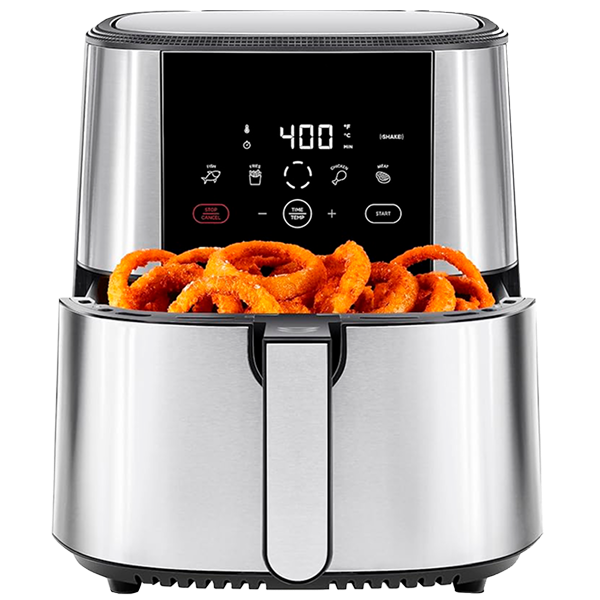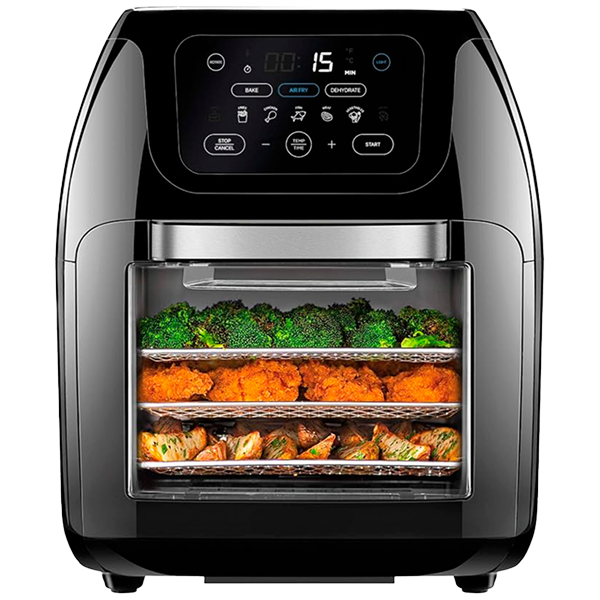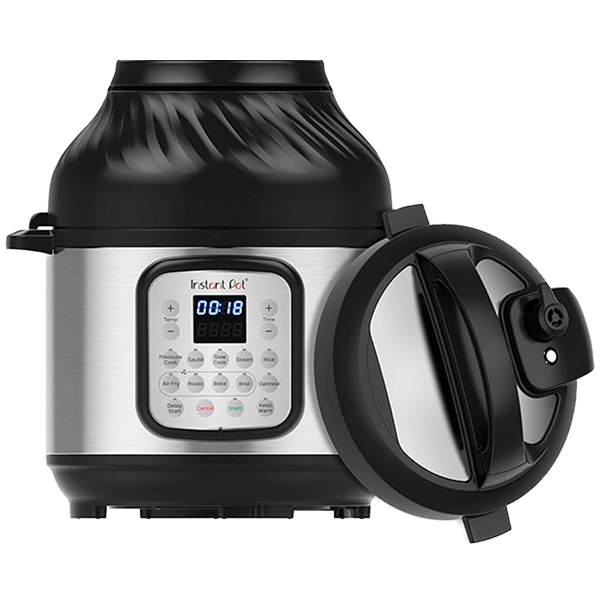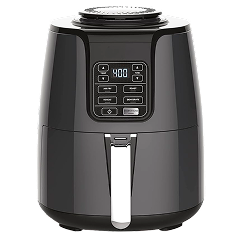Air fryers are not only the latest craze in the kitchen, but they’re among the greatest, at least in recent memory. They’re like the Harry Potter of kitchen appliances, getting people to cook who wouldn’t otherwise, as well as giving home chefs an easier, more convenient, or at least alternate method of getting dinner (or a snack) ready.
These devices are not magic. In fact, they’re surprisingly simple – they’re small convection ovens, regardless of what shape they come in. There’s a heating element inside that produces radiant heat and a fan that whips that hot air around so that food cooks quicker and more evenly.
Like all appliances in and out of the kitchen, there are good ones and there are ones that you’re better off avoiding. It does get a little more complicated than that, however, as they do come in a variety of shapes and sizes with a number of different features. So, one might be great but not right for you, while another one fits the bill perfectly.
To help you navigate all the various air fryers out there, I’ve broken down the types of air fryers and who they’re best for, as well as the different criteria best used to rate all the models out there. Buckle up, because you’re about to know a lot more about air fryers than you ever thought possible.
How To Choose an Air Fryer
There are a number of factors to consider when choosing an air fryer. Some are more important than others, but they all have a place when making that choice. Not only do you want to have a good handle on how much power you need, but internal capacity, temperature range, what kind of modes are available, and more.
Capacity
The internal capacity of an air fryer might be one of the most important considerations. The price and physical dimensions are often correlated to how much food an air fryer can cook at once.
First, be aware that you’ll see the capacity listed in liters in one place and quarts another. They’re almost one to one, so a six liter capacity is the same as a six and a third quart capacity.
The smallest models including portable air fryers and smaller basket air fryers have under a three liter capacity. Since this capacity really limits you to cooking a single serving at once, you should really only consider one of these if you want something portable or want an air fryer that needs to be stored under a dorm bed, as you can only cook a small amount of food with this.
Models between three and five liters are similar in that they only really work as a kitchen appliance for households of one or when you just want to prepare a snack.
Most regular sized basket-style air fryers fit in the five to ten liter range, and allow a decent amount of internal capacity for one or two people. If you want to create a serving of fries for two people, shoot for this range of capacity.
Toaster oven or oven-style air fryers make up the majority of models that fit in the 10 to 20 liter and the 20+ liter ranges. These models have a lot more capacity, often allowing one to cook multiple dishes at the same time. The internal capacity is more ideal for larger households or home chefs that like to do more than the bare minimum. They often allow you to cook multiple dishes at once, especially when they come with more than one tray. Imagine using multiple trays in a regular oven. It’s the same here, but smaller.
The 20+ liter models take this to the next level as these are the ones that are also big enough to rotisserie a full chicken. Most people cooking for a family will be okay with the 10 – 20 liter range if they don’t care about doing rotisserie.
Temperature
If you think that all air fryers essentially have the same temperature range, you’ll be surprised to find out that that’s not actually the case. Not every air fryer can get down to around 130 F needed for dehydrating fruit. And some machines top out at 400 F, even though some recipes require temperatures of 450 F.
Similarly, the Timer Range on air fryers is not universal, either. Just about every air fryer can get up to an hour, but plenty can’t go beyond that. If you want to dehydrate food, you not only need a low temperature, but a long cooking time. And if you want to use an air fryer for baking, you might need a longer time range.
A little more niche but also important is heating type. Most air fryers have a single heating element and that’s more than enough, especially for basket-style and smaller size air fryers. Some have dual heating elements. If you’re looking to get very large models, you might want to keep an eye out on whether there’s a second heating element to help out. The third type of heating element is the most niche. You won’t come across a lot of infrared models, but you’ll find them to be pricey thanks to this cutting edge way of heating food. Plus, they heat up almost instantaneously.
The lack of a temperature control is more of a worry with cheap models and something I would wholeheartedly just avoid if you can. Not having temperature control really limits what you can cook in the air fryer. Some foods need a certain amount of time to fully cook. You can’t just lower the time to account for temperature every time, though sometimes you can.
Wattage
The wattage of an air fryer is somewhat closely related to temperature insofar that underpowered models can only muster so much heat just because they’re limited by wattage. Models range from about 1000 to over 1,700 watts.
Models at the low-end may take longer to heat up and are going to be limited in how high of a temperature they can hit. Going from 1,000 to 1,500 watts typically offers better performance. Since models with around 1,500 watts are basket-style air fryers and don’t have a huge internal capacity, it’s more than enough power and you don’t really need to worry about finding a model with more than that.
In fact, you won’t really see basket-style air fryers with 1,700+ watts as that amount of power usually comes with toaster oven models that have more internal capacity to heat up. In regards to toaster oven air fryers, you do want more wattage as they need more power to heat up that larger internal capacity. I’ve seen some cheaper toaster oven air fryers with under 1,200 watts and they end up with, at best, mixed reviews on their performance.
Controls
Controls are a matter of preference. For instance, though most models use digital controls, there are plenty with physical ones. Having digital controls does usually means that there’s a display of some sort telling you the temperature and how much time is left. And many will prefer that, not to mention adjusting or selecting a mode with a press of a button.
Analog controls do offer a tactile feel, however, that some might like. And though you would think only cheaper models have analog controls (that is mostly true), there are some more premium models such as the Our Place Wonder Oven that uses physical controls.
If you have an air fryer with extra features (we’ll cover that below), the display helps tell you whether that feature is engaged. Maybe you have a toaster oven air fryer with an included thermometer. That thermometer is typically just a sensor that plugs somewhere into the air fryer where the display will pop up with a temperature reading, to give one example.
One of the biggest areas for consideration when it comes to an air fryer’s controls are the amount and variety of cooking modes included.
Now, most basic basket-style air fryers, especially on the cheaper side of things, top out at four distinct modes. Besides “Air Fry,” you’ll find some combination of “Reheat,” “Bake,” “Roast,” “Toast,” or even “Dehydrate,” if that particular air fryer can go low enough temperature-wise. The pricier models, especially with toaster oven air fryer models, offer a lot more including “Proof,” “Broil,” and “Rotiserrie” just to name a few.
Among the various modes, “Dehydrate,” “Broil,” and “Rotisserie” are specific use cases that you should watch out for if you have any interest in dehydrating, broiling, or doing rotisserie. After all, most other modes are just temperature and time presets.
While these are as well, for the most part, they require higher or lower temperatures and times than most air fryers can achieve. Plus, the Broil function allows a high heat situation that some air fryers can’t handle so that you can crisp the top of, say, a french onion soup or crème brûlée.
Of course, seeing these functions available in the modes lets you know right away that this particular air fryer is capable of these things.
Build
Air Fryer Type
Start with the type of air fryer. I’ll go over this more in-depth later, but here are the basics:
- Basket-style: Most common. Great for quick meals and compact kitchens.
- Oven-style: Usually larger, with trays instead of baskets. Better for batch cooking or baking.
- Multi-cookers with air fry lids: Flexible but bulkier. Good if you want one appliance for multiple cooking methods.
Note: Paddle-style air fryers are largely outdated and typically only found second-hand. They’re not part of the current mainstream market.
Size and Weight
While capacity (liters/quarts) often determines the overall size and weight, don’t ignore the external dimensions:
- Compact kitchens: Check that the unit will fit on your counter or inside a cabinet.
- Storage needs: If you plan to put it away between uses, make sure it’s not too heavy or awkward to lift.
Single vs. Dual Compartment
Most air fryers have a single cooking compartment, but a few premium models offer dual baskets with independent time and temperature controls. These are ideal if you want to cook two different dishes at once, like a main and a side. Expect to pay more for this feature.
Cooking Surface Design
- Basket-style models use a crisper plate, which sits at the bottom of the basket. Always look for a removable crisper plate, as fixed ones are difficult to clean.
- Oven-style models use removable trays, which serve the same purpose. If the tray isn’t removable, skip that model—cleaning will be unnecessarily difficult.
Ease of Cleaning
Check whether the following parts are dishwasher safe:
- Basket
- Crisper plate
- Tray
Most modern air fryers have dishwasher-safe components, but not all do. Models requiring hand-washing of internal parts or accessories can become a chore, especially with frequent use. Oven-style models often require manual cleaning of the interior walls—just like a regular oven.
Interior Materials
There’s growing concern about plastic components inside air fryers, especially:
- Basket-style units with plastic near the top heating element and fan. This is the part directly above your food.
- If you’re avoiding PFAS or microplastics, look for units with all-metal interiors or those that avoid exposed plastic near the heating element.
- Oven-style models are typically better in this regard—they tend to have fewer exposed plastic components near the cooking zone.
See-through Windows and Interior Lighting
These are convenience features, not essentials, but they improve usability:
- A see-through door or basket window lets you monitor food without interrupting the cooking cycle.
- An interior light helps make that window useful—especially in darker kitchens or with smaller foods that are harder to see.
Extra features
When considering which air fryer to buy, it’s worth thinking about what kinds of features matter to you. Some models keep things very simple, including little more than a single crisper plate or tray. Others come with a wider range of accessories and options that expand what you can do.
Toaster oven–style air fryers, in particular, often include multiple trays, each designed for specific types of cooking—like roasting, baking, or dehydrating. A few high-end models even include built-in meat thermometers that plug directly into the unit, allowing you to monitor internal food temperature in real time through the display.
While it’s difficult to objectively compare air fryers based on accessories—since it comes down to what the manufacturer includes—this does make a practical difference if you plan to cook certain dishes. For example, if you’re regularly preparing steak or rotisserie chicken, a built-in thermometer can be very useful, especially if you don’t already own one.
Safety features are another important part of the equation. One of the most essential is auto-shutoff, which stops the device when the timer runs out or when something goes wrong. While it might seem like this would be standard on all air fryers, it’s actually not.
Some lower-cost models skip it entirely, which introduces unnecessary risk. For something that heats to high temperatures on your countertop, skipping basic safety features to save a bit of money isn’t worth it. If cost is a concern, it’s still better to go with a well-reviewed budget model that includes core protections than to compromise on safety.
Smoke control is another feature that occasionally appears, though it’s less common and generally less critical than auto-shutoff. These systems usually rely on proprietary filters or airflow designs to reduce visible smoke, especially when cooking fatty or marinated foods.
If you already have a good understanding of how to adapt recipes for air frying—like avoiding excess oil or using lower temps when necessary—you can manage without it. That said, if your goal is to make the air fryer as safe and low-maintenance as possible, or if your kitchen has limited ventilation, smoke control is worth considering.
Types of Air Fryers
Basket-style
The most basic type of air fryer is the basket-style. It’s also the most recognizable one as an air fryer, usually a bit taller than wider, with a handle on the front to remove the basket from the air fryer, hence the name. The basket typically also contains a vented crisper plate on the bottom to allow the circulated hot air to get under the food. This crisper plate is typically, but not always, removable.
Though these types of air fryers are usually a little light on features and are on the smaller side capacity-wise compared to other types, they don’t take up too much countertop or storage space. This makes them ideal for those in small apartments or cramped kitchens. Or if you’re on your own, they’re perfect for just making a personal serving or heating up a snack.
The form factor also means that they’re the easiest of the various types to clean as the entire basket can usually be removed and put into the sink (sometimes even the dishwasher) to soak and wash.
And since they’re typically on the smaller side with less features, not to mention the most popular, they’re usually the most affordable.
Toaster Oven
The toaster oven-style air fryer, also referred to as oven-style, is the second most popular. And as their name suggests, it looks like a toaster oven. They sometimes are bigger, especially the ones that one might refer to as rotisserie air fryers, but they all have a front door or two to access the inner compartment.
Instead of removing a whole basket to place food into, these air fryers come with trays, often various types. You would place food on these trays to cook and then pull out or remove the trays to get the food you just cooked.
Toaster oven air fryers have much bigger capacity than basket-style models, so you can cook larger amounts of food, even cooking whole chickens in some cases. And since they come with multiple trays typically, more than one dish can be cooked at once.
Since the only part of the toaster oven that comes out are the trays, cleaning toaster oven air fryers is tougher. The trays are usually dishwasher safe, but you’ll have to clean the inside walls the same way one would a microwave – with a rag and cleaning solution.
On the bright side, they do come with plenty of features, with plenty of quality ones having over ten different cooking modes or presets to do everything from reheating, roasting, baking, and more. Of course, because of the bigger size and extra features, these are more expensive than basket-style models. While it’s tough to give concrete price differences, toaster oven-style models seem to be up to 50% more expensive.
These air fryers are great for those trying to make larger amounts of food, whether it’s roasting an entire chicken or trying to cook multiple dishes for a family.
Multi-Cooker
Multi-cookers are a bit tricky since they technically are more than one type. But since they’re a bit niche, it makes sense to gather them all under this term. When you see multi-cookers, you’ll come across things like microwaves or pressure cookers with air fryer functionality.
Combining two functionalities in one is great for those trying to save space as you don’t have to make countertop or storage space for both an air fryer and whatever other kitchen appliance you’re considering. Plus, even if they’re the most expensive of the various types of air fryers, you can save a little money buying one appliance over two.
Having the multiple functionalities also makes them more versatile than the other types of air fryers. After all, both basket-style and toaster oven air fryers can only use convection heat to cook, whereas a microwave can use electro-magnetic radiation, and pressure cookers use steam heat.
The flip side of that is if something goes wrong, then you have to replace a device that fulfills multiple functions for you.
Paddle-style
Paddle-style air fryers are a rarefied breed, but not necessarily for good reason. They’re out there though, so you should be aware of them. To define them, they’re a type of air fryer that includes a rotating paddle to push food around the basket, making it so you don’t have to pause cooking, remove the basket, and shake the food to get even results. However, if you overcrowd the basket or put softer foods in, the paddle can break or mush up whatever you’re cooking.
These types of air fryers are best for those who mainly want to cook things like french fries or veggies that don’t break down easily. Of course, the paddle can be removed so you can use this type of air fryer exactly the same as the basket-style, except that the basket has a gap in the middle for the mechanism moving the paddle around.
While I don’t see a ton of paddle-style air fryers available new – Tefal seems to be the only brand advertising new ones – you should be aware of them, in case you decide to go used or happen across an air fryer at a thrift store that looks a little different. I do recommend you skip and go with a quality option from one of the other types of air fryer.
What to Look For in an Air Fryer
It’s tough picking the best air fryer overall. Not just because there are multiple manufacturers making solid machines, but because there are so many different needs out there. For some, a feature-packed smart air fryer like Dreo’s ChefMaker or a dual-compartment air fryer from Ninja are the most ideal for their situation, while others would prefer something simple with great performance like the Cosori Turbo Blaze.
Since everyone’s needs are different, it’s important to get a handle on which criteria are most important to you.
- If you live in a small space, you need to make sure to go with something that actually fits. That means prioritizing basket-style air fryers with smaller internal capacities – I would suggest around six liters or less.
- If you’re trying to cook for your family, get something bigger, whether it’s a dual compartment air fryer or a larger capacity toaster oven model.
Consider what kind of dishes you hope to cook in one as well. Temperature range is important if you have recipes that call for very low or high heat, as not all air fryers are the same. The same thought process goes for time ranges.
Similarly, having more modes might seem better, but only if you care about versatility. If you do, then definitely look for models with more modes, focusing on which modes are important for you, whether it’s something like “Toast,” “Rotisseries,” “Dehydrate,” etc.
Also consider which additional features are make-or-break for you. Having a see-through window with an internal light is crucial for someone doing some convection baking. After all, you don’t really want to open to check and let heat out – that’s a great way to kill a soufflé, for example.
Common Mistakes to Avoid
There are a couple mistakes that people tend to make with air fryers. First, some go for the cheapest they can find. You can find good air fryers at budget-friendly prices so saving a few dollars here and there is not worth it. After all, many of these bottom of the barrel models come with tell-tale signs that they’re cheaply made.
An air fryer without temperature control or a removable tray or plate is not only more of a hassle to use than even modestly more feature-filled models, but who knows what else the manufacturer cheaped out on. Even if you’re shopping for something cheap for your kid going off to college, try to get something that’s not quite bottom of the barrel. It’s not that much more.
In a similar vein, you’ll see a few (well, a lot of) off-brand models online, especially certain big retailers with names that make no sense and seemingly no history. Be careful as you’re taking a chance with something unproven that might be a dropshipping brand that’s here today and gone tomorrow. If something goes wrong with your air fryer, they are not going to have the same warranty or customer support as established brands.
Brands
Cosori
Cosori is a newer brand that’s quickly become one of the best-selling names in the air fryer space. Their models are known for being budget-friendly yet powerful, with a variety of both basket-style and toaster oven–style options. Cosori air fryers tend to get very good reviews, especially for their performance relative to price. They offer a two-year limited warranty.
Dreo
Dreo is another relatively new company, known for forward-thinking, smart home devices. They currently only offer one air fryer, but it’s gained attention for its advanced smart features. It’s on the pricier side and comes with a one-year warranty, but stands out due to its modern design and strong user feedback.
Ninja
Ninja is arguably the most popular air fryer brand on the market. They offer a wide variety of models, including both basket-style and toaster oven–style units. Ninja is known for cutting-edge features and dual-compartment models, which are great for cooking multiple items at once. Their products tend to be more expensive than average but are consistently well rated. They come with a one-year limited warranty.
Philips
Philips was one of the first brands to bring air fryers to the mass market. While they aren’t the flashiest or most cutting-edge, their basket-style models are solid, reliable, and focused on the budget to mid-range space. Philips offers a two-year warranty, and their models are generally very well received by users.
Tefal (T-Fal)
Tefal was once known for paddle-style air fryers, but that’s no longer a focus. Today, they offer a small range of basket-style and toaster oven–style air fryers. One standout is their infrared air fryer, which heats almost instantly. Their lineup is relatively small, and they offer a one-year limited warranty.
Breville
Breville focuses exclusively on toaster oven–style air fryers, typically at the premium end of the market. Their models are known for being feature-rich, especially in terms of smart cooking functions and rotisserie capabilities. Breville units are well-reviewed and come with a two-year limited warranty.
Our Place
Better known for cookware, Our Place offers a single toaster oven air fryer in two sizes. What sets them apart is design aesthetics—their models are visually appealing and popular among style-conscious buyers. Despite the premium branding, they offer only a one-year warranty.
Instant Pot
While primarily known for pressure cookers, Instant Pot also offers a wide range of air fryers, including standalone units and multi-cookers with air fry lids. They’re among the most prolific and affordable brands in the space, offering a wide variety of sizes and styles. Reviews are generally positive, and all products come with a one-year warranty.
Chefman
Chefman is a budget brand, offering a wide variety of basket and toaster oven–style air fryers at some of the lowest prices for an established name. While they’re affordable, user ratings tend to be slightly lower than competitors. Their air fryers come with a one-year warranty.
Cuisinart
Cuisinart is a well-known kitchen appliance brand but has a relatively small footprint in the air fryer space. They do offer a few basket-style models, which are well liked and affordably priced. One standout feature is their three-year warranty, which is longer than most other brands offer.


